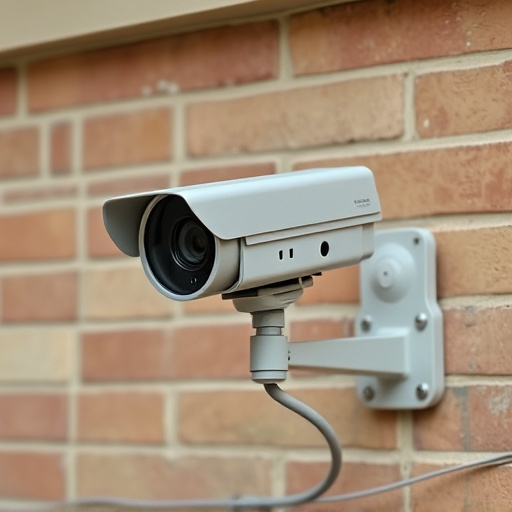Solar-powered dummy security cameras combine eco-conscious design with advanced surveillance technology, offering a strategic deterrent to intruders through LED red lights. By mimicking real camera presence and harnessing solar energy, these cameras eliminate wiring needs and reduce carbon footprints. Optimal dummy camera red light placement involves elevated angles facing entry points for maximum visibility during low-light conditions. Regular cleaning of lenses and panels ensures continued peak performance, enhancing security for both residential and commercial settings.
“Discover the future of home security with solar-powered dummy security cameras—a smart, sustainable solution. This comprehensive guide explores the intricacies of these innovative devices, from understanding their basic function to optimizing performance through strategic red light placement. Learn about the numerous benefits and diverse applications, making your space safer and more secure. By following our installation tips, you’ll ensure optimal functionality for these eco-friendly dummy cameras.”
- Understanding Solar-Powered Dummy Security Cameras
- The Role of Red Light Placement in Dummy Cameras
- Benefits and Applications of Using Solar Dummy Cameras
- Installation Tips for Optimal Performance
Understanding Solar-Powered Dummy Security Cameras
Solar-powered dummy security cameras are a clever and sustainable way to enhance home or business security. These devices combine the benefits of solar energy with advanced surveillance technology, offering a cost-effective and eco-friendly alternative to traditional security systems. At their core, they function similarly to regular security cameras, with a lens capturing footage that can be monitored remotely or stored for later review.
The key to their effectiveness lies in the dummy camera red light placement. Strategically positioned LED lights mimic the presence of a real camera, deterring potential intruders while emitting no power consumption. This clever design allows them to operate entirely off-grid, harnessing solar energy during the day and remaining active at night through integrated batteries. Such cameras provide a simple, yet powerful solution for enhancing security without the need for complex wiring or constant electricity supply.
The Role of Red Light Placement in Dummy Cameras
The strategic placement of red lights on dummy security cameras plays a significant role in their effectiveness as deterrents. These lights serve as a visual cue to potential intruders, indicating that the area is under surveillance. When positioned appropriately, the red glow can be seen from a distance, acting as a psychological barrier and discouraging unauthorized access. This simple yet powerful feature enhances the overall presence of security, making dummy cameras an even more convincing option for homeowners and business owners alike.
Optimal red light placement involves considering factors such as lighting angle, sensitivity to movement, and visibility from common entry points. Aligning the lights to cast a beam across key areas can create the illusion of constant monitoring. By strategically angling them, the cameras can cover blind spots effectively, ensuring a comprehensive security setup. This technique not only adds an extra layer of protection but also contributes to a more immersive and realistic security environment.
Benefits and Applications of Using Solar Dummy Cameras
Solar-powered dummy security cameras offer a range of benefits for both residential and commercial properties, making them an attractive option in the world of home security. One of their key advantages is the eco-friendly nature of solar energy, which reduces carbon footprints compared to traditional power sources. These cameras are designed to operate autonomously, drawing power from sunlight, eliminating the need for complex wiring or frequent battery replacements. This makes them particularly ideal for remote locations or areas with limited access to electricity.
The strategic placement of red light in dummy camera designs serves multiple purposes. Not only does it mimic the look and feel of a functional security camera, but the visible red glow can act as a deterrent to potential intruders. This simple yet effective feature adds an extra layer of protection, especially during nighttime or low-light conditions. Additionally, solar dummy cameras can be easily installed and hidden, providing peace of mind without compromising aesthetics. They are versatile and suitable for various environments, from outdoor gardens and driveways to perimeter fences and rooftops, ensuring enhanced security and surveillance.
Installation Tips for Optimal Performance
For optimal performance of solar-powered dummy security cameras, proper installation is key. One crucial tip involves strategic dummy camera red light placement. Positioning the red light at an elevated angle and facing towards potential entry points ensures it’s visible from a distance, deterring intruders even during low-light conditions. This simple adjustment can significantly enhance the camera’s effectiveness as a deterrent.
When installing, remember to place the solar panel in an area with unobstructed access to sunlight for maximum energy absorption. Ensure the camera itself is positioned at eye level or slightly elevated, providing a clear line of sight across the target area. Regular cleaning of both the camera lens and solar panel will also ensure optimal performance, as dust and debris can hinder their functionality.
Solar-powered dummy security cameras, with their strategic red light placement, offer a sustainable and cost-effective solution for home and business security. By harnessing solar energy, these cameras eliminate the need for electrical cords or frequent battery replacements. The benefits are clear: enhanced visibility at night through red LED lights, deterring potential intruders, and providing peace of mind. Whether installed in urban areas with bustling streets or remote rural locations, dummy cameras with optimal red light placement can serve as an effective first line of defense, ensuring a safer environment for all.
